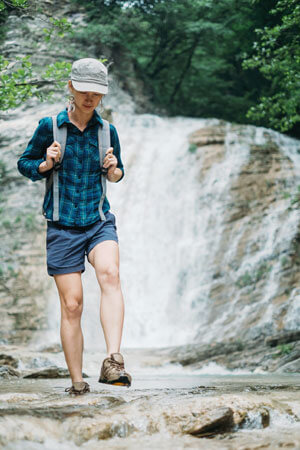Take a hike
Minnesota offers beautiful and diverse hiking trails for all levels of hikers. With more than 70 state parks and three national forests to explore there are endless opportunities to enjoy the great outdoors of Minnesota. Catch the sight of an eagle soaring through Sibley State Park, the sounds of a waterfall crashing over the rocks in Grand Portage State Park, the breathtaking views of the Mississippi River Valley in Great River Bluffs State Park and soak in the abundance of fall colors in Tettegouche State Park.
My husband I have been to all of these state parks and hope to hike in many more. However, so that we can continue to do so we follow the tips and guidelines below. Will you join us on our quest to visit every state park in the state of Minnesota? Happy hiking to you!
10 things needed on every hike
- Appropriate footwear. Trail shoes are fine for a short day hike that doesn’t involve carrying a heavy pack or negotiating difficult terrain. But hiking boots, which offer more support, are a better choice for longer hikes, carrying heavier loads or traveling on more challenging terrain.
- Map and compass. Even if you have a GPS unit, you need a map and compass as a backup.
- Water. It’s important to carry enough water and have a way to purify water from sources along the trail.
- Food. Take extra food in case you’re out longer than you planned because of getting lost, suffering an injury or traversing more difficult terrain than you expected.
- Clothing. Even if the weather forecast is good, bring rain gear and extra clothing in case the prediction is wrong. Dress in layers so you can adjust to changing weather and activity levels. Do not wear cotton clothes — which trap moisture close to the skin. Always carry a hat.
- Sunscreen
- Sunglasses
- Emergency signals. Even on a day hike, you need a whistle, flashlight/headlamp and matches or lighter in case of an emergency. Three short bursts on a whistle is a signal for help.
- First-aid. Always carry a first-aid kit — better yet — take a first-aid class. Prepackaged first-aid kits for hikers are available at outfitters. Another important item is a knife or multi-purpose tool, for cutting strips of cloth into bandages, removing splinters and fixing broken eyeglasses.
- Pack. Your daypack or backpack should be comfortable and have a rain cover to keep your belongings dry.
The U.S. National Park Service has more about hiking safety.
